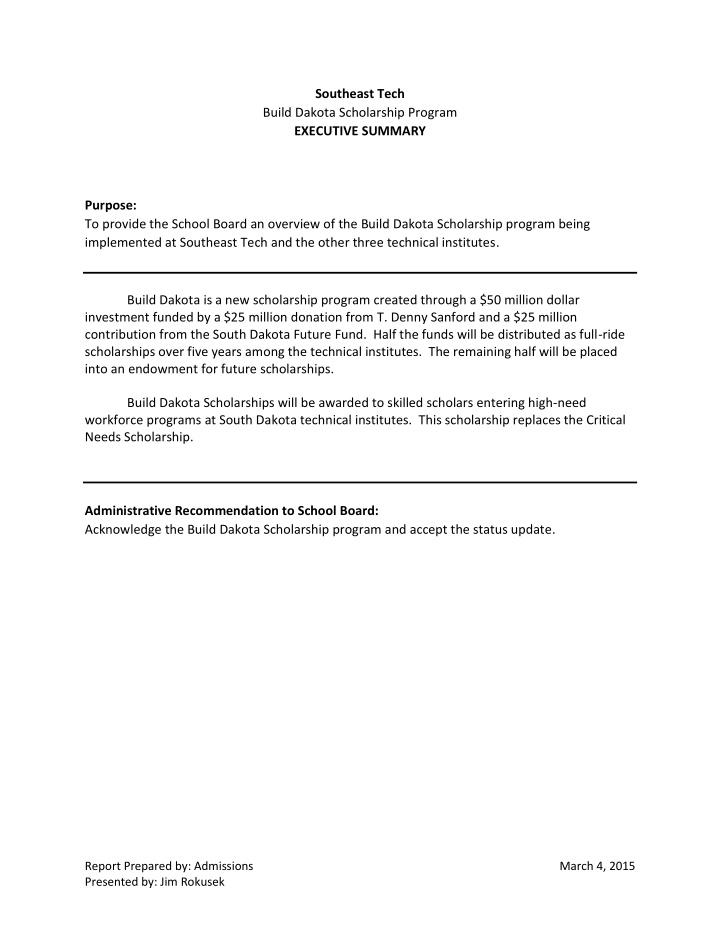



Southeast Tech Build Dakota Scholarship Program EXECUTIVE SUMMARY Purpose: To provide the School Board an overview of the Build Dakota Scholarship program being implemented at Southeast Tech and the other three technical institutes. Build Dakota is a new scholarship program created through a $50 million dollar investment funded by a $25 million donation from T. Denny Sanford and a $25 million contribution from the South Dakota Future Fund. Half the funds will be distributed as full-ride scholarships over five years among the technical institutes. The remaining half will be placed into an endowment for future scholarships. Build Dakota Scholarships will be awarded to skilled scholars entering high-need workforce programs at South Dakota technical institutes. This scholarship replaces the Critical Needs Scholarship. Administrative Recommendation to School Board: Acknowledge the Build Dakota Scholarship program and accept the status update. Report Prepared by: Admissions March 4, 2015 Presented by: Jim Rokusek
The Free Rid ide That Can Take You Anywhere Build Dakota is a new scholarship program created through a $50 million dollar investment funded by a $25 million donation from T. Denny Sanford and a $25 million contribution from the South Dakota Future Fund. Build Dakota Scholarships will be awarded to skilled scholars entering high-need workforce programs at South Dakota technical institutes.
Pr Prog ogram am Details Details Both in-state students and out – of – state students are eligible for the scholarship The scholarships will support tuition, fees, books and other required program expenses in the eligible technical institute programs. Recipients of the scholarships will commit to living and working in the state, in their field of study, for three years following graduation. In the first five years, a projected 300 scholarships will be awarded annually. Beyond the first five years, the endowment will support approximately 50 full-ride scholarships.
Eligibilit Eligibility Requir equirements ements Interest in the high-need workforce areas U.S. citizen or U.S. national Applicants need not be South Dakota residents Meet program entrance requirements Financial need Demonstrated aptitude through one or more of the following: The National Career Readiness Certificate (NCRC) or other industry-recognized certifications in the career area. Technical, dual or concurrent credit courses taken in the career interest area. Career & Technical Education coursework completed in the career interest area. Work-based learning experiences, internships or work experience in the career interest area.
Southeast T Southeast Tec ech Pr h Prog ograms ams Automotive Tech Civil Engineering Tech Collision Repair & Refinish Tech Construction Management Diesel Tech Electrician Electronics HVAC Mechanical Engineering Tech Mechatronics Plumbing / Mechanical Systems Welding
Student Commitment Student Commitment In accepting scholarship awards, recipients will agree to: Enroll full time in a technical institute program determined as a high – need workforce area in South Dakota. Maintain a grade point average of 2.5 or higher. Complete the program as a full time student. Following graduation, work full time in the field of study in South Dakota for a minimum of 3 years. http://builddakotascholarships.com/#apply
Ben Benefits efits of of a a T Tec echn hnical ical De Degree ee Who do you think makes $30,000 more in a year, on average: A construction manager or an accountant? The answer is…. The construction manager! Surprised? You shouldn't be. Today's tech graduates are skilled scholars reaching new heights of success. Check out these stats: 22 percent of workers with associate's degrees earn more than median bachelor's degree holders, and 14 percent earn more than median graduate degree holders.* Workers with two-year degrees in STEM subjects (science, technology, engineering and math), in fact, have greater average lifetime earnings than college graduates in most other career areas. For example, the lifetime earnings of these two-year degrees: computer software engineers ($3.0 million); aircraft mechanics ($2.3 million); and electricians ($2.1 million). All exceed average lifetime *Carnevale, A. P., Strohl, J., & Smith, N. (2009). Help wanted: earnings of college-educated school administrators ($2.0 million); Postsecondary education and training required. New directions for community colleges, 2009 (146), 21 – 31. writers and editors ($2.0 million); and teachers ($1.8 million).** **Carnevale, A. P., Rose, S. J., & Cheah, B. (2011). The college payoff: Education, occupations, lifetime earnings. Washington, DC: Georgetown University Center on Education and the Workforce.
Scholarship Promotion • $400,000 state-wide campaign • TV and Radio • Southeast Tech Promotion • Radio Advertisements • Social Media • Postcards • Flyers • Counselor Meetings • High School Visits • Classroom Presentations
Current Scholarship Applications As of Monday, March 2 nd , we have 101 applications • 44 are recent admission applications since the scholarship announcement • 43 prior to that time • 14 non-qualified applicants All applications are due March 31, 2015
Any questions?
Recommend
More recommend